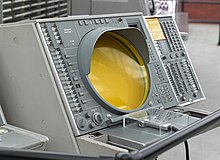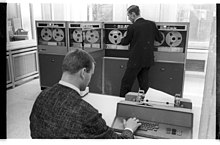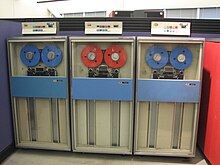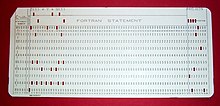User:TitanOfOld/Draft Revision of Computer Operator
This article needs to be divided into sections. (February 2019) |
A role in IT, a computer operator oversees the running of computer systems, ensuring that the machines, and computers are running properly.[1]
The job of a computer operator as defined by the United States Bureau of Labor Statistics is to "monitor and control ... and respond to ... enter commands ... set controls on computer and peripheral devices. Excludes Data Entry."[2]
Overview[edit]
The position has evolved from its beginnings in the punched card era. A Bureau of Labor Statistics report published in 2018 showed that, in the public sector, the major employer of those categorized as Computer Operator was United States Postal Service. In the private sector, companies involved in data processing, hosting, or related services employed computer operators at an even higher rate. The states in the USA with the highest employment for computer operators, as of 2018, are: New York, Texas, California, New Jersey, and Florida.[3]
The former role of a computer operator was to work with mainframe computers which required a great deal of management day-to-day including manually running batch jobs; however, now they often work with a variety of different systems and applications. The computer operator normally works in a server room or a data center, but can also work remotely so that they can operate systems across multiple sites. Most of their duties are taught on the job, as their job description will vary according to the systems and set-up they help manage.
Responsibilities of a computer operator may include: Monitor and control electronic computer and peripheral electronic data processing equipment to process business, scientific, engineering, and other data according to operating instructions. Monitor and respond to operating and error messages. May enter commands at a computer terminal and set controls on computer and peripheral devices. Excludes "Computer Occupations" (15-1100) and "Data Entry Keyers" (43-9021).
The role also includes maintaining records and logging events, listing each backup that is run, each machine malfunction and program abnormal termination. Operators assist system administrators and programmers in testing and debugging of new systems and programs prior to their becoming production environments.
Modern-day computing has led to a greater proliferation of personal computers, with a rapid change from older mainframe systems to newer self-managing systems. This is reflected in the operator's role. Tasks may include managing the backup systems, cycling tapes or other media, filling and maintaining printers. Overall the operator fills in as a lower level system administrator or operations analyst. Most operations departments work 24x7.
A computer operator also has knowledge of disaster recovery and business continuity procedures. Formerly this would have meant sending physical data tapes offsite, but now the data is more than likely transmitted over computer networks.
A computer operator can work inside the home on the network editing domains and nets, or they can work on the road or as part of a company.[4]
Specializations[edit]
Console operator[edit]

2+ decades before introduction of the IBM 3036 (IBM 303X offerings, which included a Dual-display console


A console operator typical interacts with point of sale system, or is engaged in customer service. These individuals would be trained to use specialized equipment related to their duties.
One example of specific hardware used by a console operator is the IBM 3066 Model 2 sytem console, which included a light pen as an interface device.
Peripherals operator[edit]
A peripherals operator uses dedicated peripheral equipment connected to computer(s) such as printers, scanners, or storage devices for data transfer to and/or from computers.[5]
Tape operator[edit]




Historically, tape operators were in charge of swapping out rolls of paper or magnetic tape that stored computer data or instructions.
In the present day, this is now a position in the entertainment field known as a tape op.
Card reader operator[edit]



Depending on the type of card reader, either the "9-edge" or the "12-edge" was towards the operator inserting the cards - but the deck of cards was always placed face down.
The United States Army's wordings were:
- Load cards in hopper face down, 12 edge out, column 1 to the left (1977)[6]
- Place cards in hopper face down with 12 edge to operator (1981)[7]
- 12 edge / face down : IBM orientation.
nine-edge (also face down) : some other card readers.
Tab operator[edit]

The tab operator (short for tabulating) would be responsible for preparing and operating tabulating machines to produce statistical results.[8]
The 1980 census specifically counted Tab operators ("Tabulating-machine operator").[9]
Hardware such as the IBM 08x sorter series were called tabulating equipment.
- Not to be confused with the service industry profession of where, in some countries, the individual would be responsible for maintaining records of amounts due. That is, these tab operators keep tab on bar-bills.[10][11]
stuff to add in[edit]
tape librarian
peripherals operator: card reader, printers/setup
HASP/ASP
past/punched card era; 21st century?
from S/168 - apply as needed
See also[edit]
References[edit]
- ^ "Computer Operators". Bureau of Labor Statistics. Retrieved August 2, 2017.
- ^ "Occupational Employment and Wages, May 2018: 43-9011 Computer Operators". Bureau of Labor Statistics.
- ^ "Computer Operators". www.bls.gov. Retrieved June 11, 2019.
- ^ "Data Entry Operator, Computer Operator, Work From Home, Part-time @HomeWhatsapp To HR 06238539995 -5 Yr Exp - HR Executive / Recruiter Job Mangalore, Mayiladuthurai - ID:23760096". MonsterIndia. Retrieved June 12, 2019.
- ^ "Work Processes Schedule". United Services Military Apprenticeship Program (USMAP). Retrieved June 11, 2019.
- ^ Soldier's manual: digital subscriber terminal equipment repairman, MOS 34F, skill levels two and three. Department of Defense, Department of the Army, Headquarters. 1977.
- ^ MOS 72E: combat telecommunications center operator. 1981.
- ^ Morgan, Richard. "TABULATING MACHINE OPERATOR (400)". militaryyearbookproject.com. Retrieved June 11, 2019.
- ^ 1980 Census of Population: Classified Index of Industries. United States. Bureau of the Census. 1980.
- ^ "Tab Operator Jobs In Australia".
.. positions at kwinana, star entertainment ... including bartenders related to tab operator
- ^ Gary Regan (2003). The Joy of Mixology. p. 67. ISBN 0609608843.
When people run a tab (ask to pay at the end of the evening rather than ...
